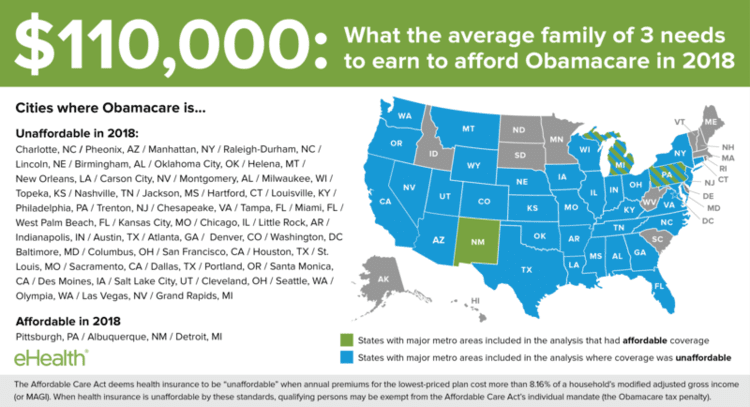The high costs of Obamacare
Obamacare Is Failing the Middle Class
Middle-class Americans, who have been hardest hit by Obamacare, are desperate for Congress to do something — anything — to lower costs.
Today, health insurance can cost more than a mortgage. The average family of four will face a staggering $22,622 in health insurance and related medical costs this year ($14,300 for premiums with an $8,322 deductible). The average annual cost of a mortgage (principal and interest) is about $18,000 for a $309,000 house.
Obamacare, of course, is already unaffordable for millions of Americans. It was supposed to reduce costs by $2,500 per family but costs increased by $4,372 per family between 2010 and 2016. If costs increase by just 10 percent in 2018 (some analysts are predicting 28 percent increases), Obamacare will be untenable for middle-class families. These families make up the majority of our customers at eHealth.com, a Silicon Valley firm that pioneered online shopping for health insurance.
By its own definition of affordability, Obamacare will be out of reach for families of three who don’t qualify for a subsidy in 94 percent of cities — or 47 out of 50 markets — which we examined in a new study. (See graphic.) The Affordable Care Act deems health insurance to be “affordable” if the cheapest plan available costs less than 8.16 percent of your modified adjusted gross income.

Middle-class families are essentially going over Obamacare’s “subsidy cliff” — the complete drop off of subsidies when household income reaches 401 percent of the Federal Poverty Line — and are falling into a pit where coverage is unaffordable for all but the wealthy. For instance, the moment a family’s income exceeds 400 percent of the Federal Poverty Level ($89,000 for a family of three) their unsubsidized insurance costs can jump as high as $20,000. This is a de factoachievement tax — work harder and face a harsh penalty.
Once consumers fall into this pit they have to receive massive and unrealistic income increases to climb out. For example, that family of three earning 1 percent too much to qualify for government subsidies would need to increase its annual household income by an average of nearly 33 percent or $29,000 before the lowest-price Obamacare plan available to them would meet the law’s definition of “affordable.” Not many families enjoy that kind of raise, which is more than 10 times the typical annual growth rate in wages.
Families in this situation are generally exempt from the tax penalty for going without qualifying coverage. But, they’re uninsured and looking for options. Congress should listen to Americans who consistently say they’re fed up with rising costs and want to pick and choose their coverage options — not everyone needs maternity or pediatric care, for example. Health-care customers are forced by Obamacare to buy a yacht — what one customer of ours called a “boatload of benefits” — when they can often only afford a rowboat.
As Congress considers what they can do to reform health care, they’d be wise to remember that Obamacare’s federalized one-size-fits all system has been failing self-employed entrepreneurs and small business owners for four straight years. It’s time for new ideas.
In the real world, individual mandates don’t work. People can’t be compelled to buy things they don’t want, don’t need, or can’t afford. Individual incentives are far more effective at forcing competition, controlling costs, and creating choices. A true market creates a harbor full of everything between rowboats and yachts to meet people’s unique needs.
The good news for consumers is that when Obamacare fails its own affordability test they’re liberated from the law’s individual mandate and tax penalties. Innovators in the health-care sector, including our firm, will be offering new packages of insurance plans with real choices and options to serve those customers. These stopgap packages don’t cover all of Obamacare’s requirements, but they provide a measure of protection from high medical costs that these customers can actually afford.
Meanwhile, those touting a single-payer solution ignore the fact that states like California and Vermont have already investigated single-payer and rejected it. Why? Because the costs were untenable. Single-payer means single-shopper — and that shopper isn’t you.
It’s time for politicians to trust and empower consumers. Choice and competition have always worked to lower costs and improve quality. The invisible hand of the market is more compassionate and equitable than any government system devised so far.
Scott Flanders is the CEO at eHealth, Inc.
For more Articles in Economy click here









